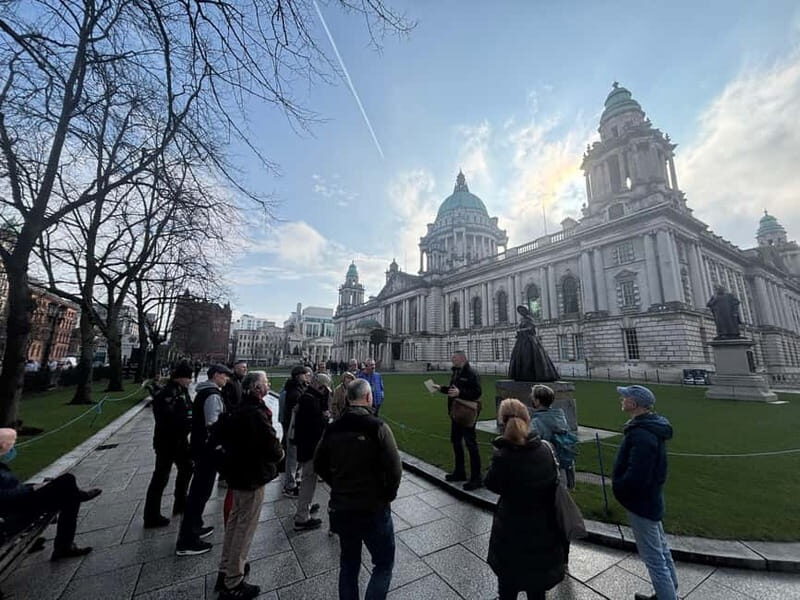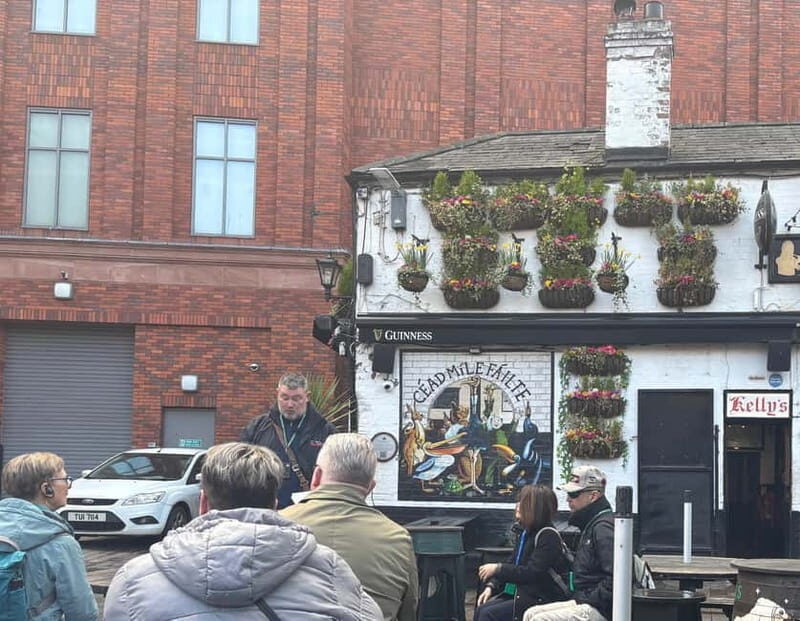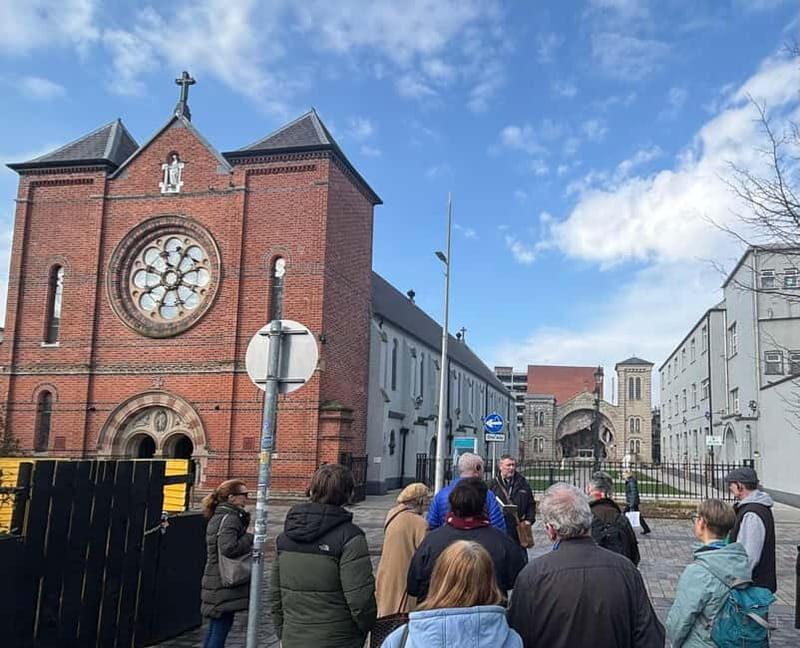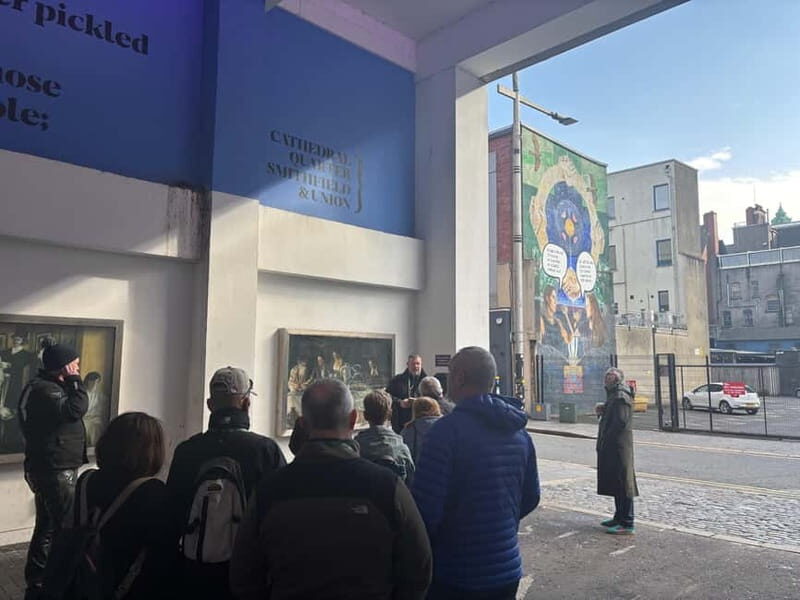Belfast: ‘1798 – A Belfast Rebellion’ Walking Tour offers a compact yet compelling journey into one of Northern Ireland’s most turbulent and formative moments. For just under three hours, you’ll stroll through Belfast’s city centre, visiting historic sites linked to the 1798 Rebellion, hearing stories of the United Irishmen, and gaining insight into how this uprising shaped the city and the nation. Led by knowledgeable local guides—like the friendly Sean or Fiona—you’ll get a detailed narrative that balances the rebellion’s significance with its sometimes misunderstood legacy.
This tour is notably well-reviewed for its engaging storytelling and well-chosen stops, such as St Mary’s Church, Belfast’s first Roman Catholic church, and the Linen Hall Library, which played a role in the repression of revolutionary ideas. We particularly appreciated the depth of context provided about the Presbyterian influence on the rebellion and Belfast’s broader social fabric at the time. The tour’s flat, under-two-miles route makes it accessible for most, and the inclusion of Vox headsets ensures everyone can follow the commentary clearly—even in the bustling streets.
A potential consideration is the tour’s limited schedule—it’s offered only on the first and third Saturday of each month at 10 am—so planning ahead is essential. Also, since it’s mainly a walking experience focused on historical sites, if you’re seeking an indoor or museum-based exploration, this might not be the ideal fit. It suits travelers with a keen interest in history, Irish culture, or those wanting an authentic, guided walk that offers more than just surface-level facts.
Key Points

- Authentic storytelling from passionate local guides brings Belfast’s 1798 Rebellion alive.
- Accessible route: less than two miles on flat ground, suitable for most fitness levels.
- Historical depth: visits to significant sites like St Mary’s Church and Linen Hall Library.
- Insightful context: learn how religious, political, and social factors intertwined during the rebellion.
- Limited schedule: available only twice a month, so booking in advance is wise.
- Value for money: includes a guided tour, headset audio, and access to key locations.
A Deep Dive into the Tour

If you're drawn to exploring Belfast on foot, we've looked into these other walking experiences
Starting Point: City Hall’s Gates
The tour kicks off at City Hall’s front gates on Donegall Square North, a perfect spot to gather and set the stage. The guides, wearing the DC Tours logo, greet you warmly and hand out headsets—a small but significant detail that makes listening much easier amid Belfast’s lively streets. We find this helpful, especially if the group is larger or if there’s some street noise.
From here, the narrative begins, transporting you into a Belfast in the late 18th century, when the city was expanding through shipbuilding, linen production, and trade. The guide sketches a picture of Belfast as a bustling, optimistic town, with imports of tobacco, rum, sugar, and wine fueling both commerce and social life. This setting provides useful context for understanding why the social tensions of the time erupted into violence.
Belfast’s First Catholic Church: St Mary’s
A short walk brings you to St Mary’s Church, Belfast’s first Roman Catholic church, opened in May 1784. This stop is especially meaningful because it highlights the religious diversity that played into the rebellion’s complex fabric. The guide explains how Presbyterian and Catholic communities interacted, with the Presbyterians often supporting democratic ideals that helped galvanize support for the United Irishmen, who aimed for a united, independent Ireland.
The scene is set with a guard of honor from the Belfast Volunteers, emphasizing the mixed loyalties and tensions. We appreciated the detailed stories about how these religious communities, despite differences, shared democratic ideals—an important factor for understanding Belfast’s history.
Rosemary Street & McCracken’s Family Home
Just a short stroll away, the tour visits Rosemary Street, known for its large Presbyterian Meeting Houses and the home of Henry Joy McCracken, a key leader in the rebellion. The guide elaborates on how Presbyterian beliefs and democratic structures contributed to the revolutionary spirit, which is often overlooked in simplified histories. This site helps you grasp how religious and political support intertwined, fueling the uprising.
More Great Tours NearbyThe Court Martial and Historic Sites
Next, the Exchange and Assembly Rooms stand as the site of Henry Joy McCracken’s court martial—a grisly yet poignant moment in Belfast’s history. The guide recounts the trial and subsequent execution with sensitivity, bringing history to life through storytelling. The view of High Street from the site gives a sense of the town’s busy atmosphere, day and night.
Other notable stops include the Joys Entry—a street evocative of Belfast’s bustling commerce—and the Muddlers Club, a historic venue that echoes Belfast’s social camaraderie during the period. These sites, with their stories and architecture, paint a vivid picture of a town on the edge of revolutionary change.
The Linen Hall Library
The Linen Hall Library closes the loop on the tour, where Thomas Russell, a former soldier and leader of the United Irishmen, was arrested in 1796. The library itself, founded as a cultural and intellectual hub, symbolizes Belfast’s early efforts at promoting knowledge and societal progress. The guide discusses how the library became a target, reflecting fears of revolutionary ideas spreading—an example of how culture and politics intersected.
Reflecting on the Impact
Back at City Hall, the guide encourages reflection on how the 1798 Rebellion influenced Irish history and its complicated memory in modern Belfast. You’ll learn how it’s sometimes shunned or misunderstood, yet it represented hope for equality and liberty—values that resonate even today, as seen in the Good Friday Agreement.
Practical Details and Value

At just 2.5 hours, this tour offers a meaningful deep dive into a pivotal moment for Belfast, especially for history buffs or curious travelers wanting to understand the city beyond its famous shipyards or murals. The cost is reasonable considering the guided expertise, headset clarity, and access to significant sites.
The schedule—offered only on the first and third Saturdays at 10 am—means planning is necessary, but it also ensures a small, engaged group. The route is flat and less than two miles, making it accessible for most visitors, including those with limited mobility.
The local guide’s stories add warmth and personality, transforming facts into memorable narratives. Several reviews praise guides like Sean and Fiona for their enthusiasm and knowledge, making the experience both fun and educational.
Why it’s Worth Considering
If you love Irish history, want a more nuanced understanding of Belfast’s past, or simply prefer walking tours that avoid the typical museum crowds, this experience offers a refreshing perspective. It’s particularly suited for travelers who appreciate authentic storytelling and want to see the city through a historical lens.
Final Thoughts

This walking tour is a well-balanced, engaging glimpse into Belfast’s revolutionary past. It expertly combines site visits, storytelling, and historical context to help you see the city’s streets with new eyes. The focus on the United Irishmen, their motivations, and the social fabric of the time make it more than just a list of facts—it’s a narrative about change, hope, and the complexities of Irish identity.
The tour’s value lies in its deep, authentic insights delivered by passionate guides, making it a worthwhile addition for anyone interested in understanding Belfast’s roots. It’s best suited for history enthusiasts, curious travelers, or those wanting a meaningful, guided walk that brings Belfast’s story to life.
For visitors wanting to connect past and present, this tour offers a thoughtful, memorable experience that complements other explorations of Belfast, such as the Titanic or political murals. It’s a compelling way to deepen your appreciation of this vibrant city.
FAQ
How long is the Belfast ‘1798’ walking tour?
The tour lasts approximately 2.5 hours, providing plenty of time to explore key sites and hear detailed stories without feeling rushed.
Where does the tour start and end?
It begins and finishes at the gates of Belfast City Hall on Donegall Square North, a central and easy-to-find location.
Is the route suitable for all mobility levels?
Yes, the route is less than two miles and completely flat, making it accessible for most visitors, including those with limited mobility.
How often is the tour available?
The tour runs on the first and third Saturdays of each month at 10 am. Be sure to book ahead as spots can fill up quickly.
Does the tour include any physical visits inside buildings?
The tour mainly involves outdoor site visits; some stops involve walking through historic streets or viewing buildings from the outside. Inside visits are not specified.
What is included in the ticket price?
Your ticket covers the guided walk, headsets for clear listening, and access to historic sites along the route, offering good value for an informative experience.
To sum it up, the ‘1798 – A Belfast Rebellion’ walking tour is an excellent way to explore Belfast’s revolutionary past in a way that’s engaging, authentic, and accessible. It suits travelers who crave historical depth, enjoy guided walks, and want to connect with the city’s stirring stories beyond the usual tourist spots. With knowledgeable guides, meaningful site visits, and a focus on the social and political currents of the time, it’s an experience that truly enriches your understanding of Belfast’s complex identity.
You can check availability for your dates here:More Walking Tours in Belfast
More Tours in Belfast
- Game of thrones -Giants causeway luxury tour 9 hrs 25 locations
- Neon Night Party Bike Tour (Private Bike)
- Haunted Belfast Exploration Game and Tour
- Belfast: Giant’s Causeway Tour w/ Titanic Exhibit Admission
- Morning Giants Causeway Half Day Tour from Belfast
- From Belfast: Full-Day Giants Causeway Land and Boat Tour
More Tour Reviews in Belfast
- Ireland: Giants Causeway, Donegal, private luxury car, 3-day
- St Patrick’s Centre & Burial Site + Hillsborough Castle & Gardens
- Game of thrones -Giants causeway luxury tour 9 hrs 25 locations
- Luxury Mercedes Bespoke Game of thrones and Giants causeway 9hrs
- Neon Night Party Bike Tour (Private Bike)
- Haunted Belfast Exploration Game and Tour
More Belfast experiences we've covered
- Ireland: Giants Causeway, Donegal, private luxury car, 3-day
- St Patrick’s Centre & Burial Site + Hillsborough Castle & Gardens
- Game of thrones -Giants causeway luxury tour 9 hrs 25 locations
- Luxury Mercedes Bespoke Game of thrones and Giants causeway 9hrs
- Neon Night Party Bike Tour (Private Bike)
- Haunted Belfast Exploration Game and Tour
- Belfast to Dublin Transfer
- Belfast: Giant’s Causeway Tour w/ Titanic Exhibit Admission
- Morning Giants Causeway Half Day Tour from Belfast
- From Belfast: Full-Day Giants Causeway Land and Boat Tour
- Enchanted Shores: Belfast to Giants Causeway
- Afternoon Giants Causeway Half Day Tour from Belfast
